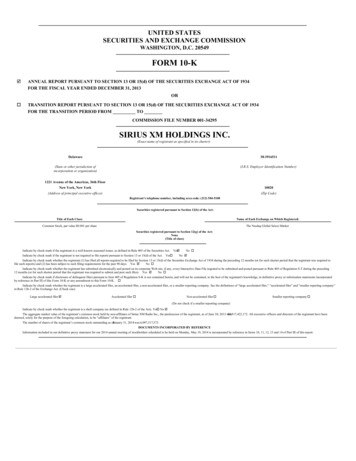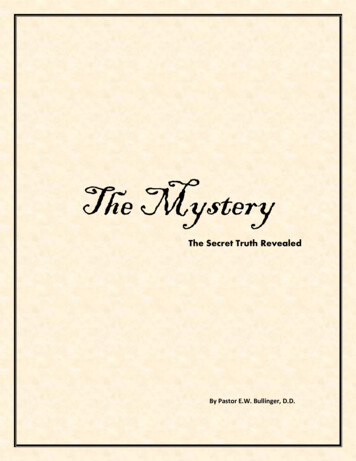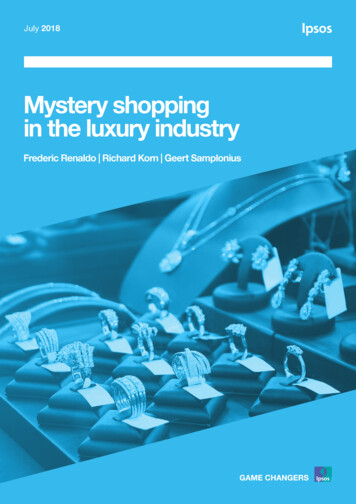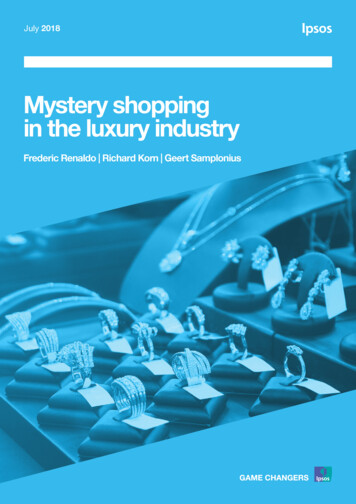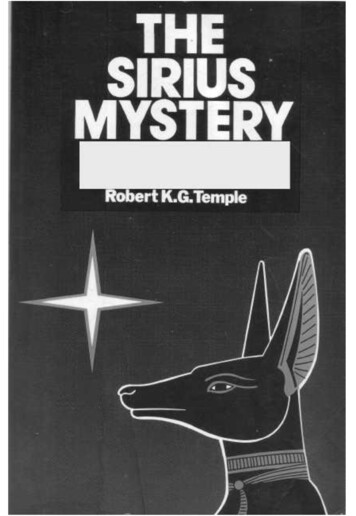
Transcription
The Sirius MysteryRobert TempleACKNOWLEDGEMENTSMy first thanks must go to my wife, Olivia, who has been an excellent proofreader and collater and who made the greatest number of helpful suggestionsconcerning the manuscript.Two friends who read the book at an early stage and took extreme painsto be helpful, and devoted much of their time to writing out or explaining tome at length their lists of specific suggestions, are Adrian Berry of the LondonTelegraph, and Michael Scott of Tangier. The latter gave meticulous attentionto details which few people would trouble to do with another's work.This book would never have been written without the material concerningthe Dogon having been brought to my attention by Arthur M. Young ofPhiladelphia. He has helped and encouraged my efforts to get to the bottomof the mystery for years, and supplied me with invaluable materials, includingthe typescript of an English translation of Le Renard Pale by the anthropologistsGriaule and Dieterlen, which enabled me to bring my survey up to date.Without the stimulus and early encouragement of Arthur C. Clarke ofCeylon, this book might not have found the motive force to carry it throughmany dreary years of research.My agent, Miss Anne McDermid, has been a model critic and adviser atall stages. Her enthusiasm and energy are matched only by her penetratingintuition and her skill at negotiation.Others who have read all or part of this book and who made helpfulsuggestions of some kind are Professor W. H. McCrea of the Department ofAstronomy, University of Sussex, John Moore of Robinson & Watkins, BrendanO'Regan of the Stanford Research Institute, Edward Bakewell of St Louis,and Anthony Michaelis of the Weizmann Institute Foundation.I am indebted to Adrian and Marina Berry for bringing me into touch withA. Costa, and to A. Costa for generously supplying his splendid photographsof the Dogon, some of which appear in this book, and also for his introductionto Mme Germaine Dieterlen. I am indebted to Mme Dieterlen for giving her
permission and the permission of the Societe des Africainistes of Paris (of whichshe is Secretary-General) to publish in English the entire article 'Un SystemeSoudanais de Sirius', which Mme Dieterlen wrote in collaboration with thelate Marcel Griaule.Among those whom I have consulted on specific points in my research andwho have been extremely helpful are Geoffrey Watkins, Brigadier R. G. S.Bidwell, O.B.E., the Hon. Robin Baring, James Serpell, Seton Gordon,Herbert Brown, and Robert and Pauline Matarasso. I am also indebted forhelp or encouragement of varying kinds to Fred Clarke, Professor CyrusGordon, Robert Graves, Kathleen Raine, William Gunston, Professor D. M.Lang, Professor Charles Burney, Professor O. R. Gurney, Dr Irving Lindenblad,Dr Paul Murdin, Hilton Ambler, Gillian Hughes, Carol MacArthur, R.Markham, Richard Robinson, Dr Michael Barraclough, and Angela Earll.In production of this book my British editor, Mrs Jan Widdows, andviiiACKNOWLEDGEMENTSmy American editor, Thomas Dunne, have been cooperative, helpful, andsympathetic. The cartographer Daniel Kitts has cheerfully prepared mapsand diagrams to requirements which were often exasperating. Miss MaryWalsh showed ingenuity in picture research. Stephen du Sautoy has also beenhelpful and shown a great deal of imagination in connection with productionof the British dust-jacket design, allowing the author a considerable say in amatter which is often barred to him.I would like to acknowledge indirect debts to the African priests Manda,Innekouzou, Yebene, and Ongnonlou, without whom the subject for this bookcould not honestly be said to exist, since it probably could never have beenformulated. Two early pioneers deserve especial mention: the late Sir NormanLockyer, who found ways to consider together the previously separate fields ofastronomy and archaeology, and the late Thomas Taylor of London, whodevoted his life to the translation and exposition of texts which have survivedthe centuries of malignity, abuse, book burnings, and slaughter which for twomillennia have been the fate of those who adhered to 'the Great Tradition' nor did Taylor himself escape the consequences of his position in pain andsuffering. Thanks are also due to the philosopher Proclus for making publiccertain specific allusions to secret traditions which he might have concealed.r. K. G. t.
AcknowledgementsAuthor's NoteWhat is the Mystery?CONTENTSpagexiTO THE READERIPART ONEThe Sirius Question is posed1The Knowledge of the DogonA Sudanese Sirius System by M. Griaule and G. Dieterlenii35PART TWOThe Sirius Question is rephrased2 A Fairytale553 The Sacred Fifty824 The Hounds of Hell1015 The Oracle Centresl2l6 Origins of the Dogon1537 The Rising of 'Serpent's Tooth'1758 A FablePART THREEBeyond the Mystery
APPENDICESIThe Moons of the Planets, the Planets around Stars, and Revolutionsand Rotations of Bodies in Space - Described by the NeoplatonicPhilosopher Proclus223IIThe Surviving Fragments of Berossus, in English Translation24.8III Why Sixty Years?258IV The Meaning of the E at DelphiV Why the Hittites were at Hebron in Palestine265268VI The Dogon Stages of Initiation273BibliographyIndex283AUTHOR'S NOTESummaries follow each chapter in Part Two. The sheer amount of the materialdealt with makes it advisable for the reader to put it into a smooth perspectiveby reading over these summaries which have been prepared so that the readermay refresh his memory if he wishes. The author can offer no apology for thecomplexity of the material, but he can present these slight aids for itscomprehension.Every effort has been made to trace the ownership of all illustrative materialreproduced in this book. Should any error or omission in acknowledgement havebeen made the author offers his apologies and will make the necessary correctionin future editions.
What is the Mystery?The question which this book poses is: Has Earth in the past been visited byintelligent beings from the region of the star Sirius ?When I began writing this book in earnest in 1967, the entire question wasframed in terms of an African tribe named the Dogon, who live in Mali in theformer French Sudan. The Dogon were in possession of information concerningthe system of the star Sirius which was so incredible that I felt impelled toresearch the material. The results, in 1974, seven years later, are that I havebeen able to show that the information which the Dogon possess is really morethan five thousand years old and was possessed by the ancient Egyptians inthe pre-dynastic times before 3200 B.C., from which people I show that theDogon are partially descended culturally, and probably physically as well.What I have done, therefore, is to push back by over five thousand years theterms of reference of the original question, so that it now becomes moretantalizing than ever. But now that I have done that, it becomes less easy toanswer. The Dogon preserve a tradition of what seems to have been an extraterrestrial contact. It is more satisfactory not to have to presume the preposterousnotion that intelligent beings from outer space landed in Africa, impartedspecific information to a West African tribe, then returned to space and leftthe rest of the world alone. Such a theory never really struck me as possible.But in the beginning it did have to serve as a working hypothesis. After all, Ihad no idea that the Dogon could have preserved ancient Egyptian religiousmysteries in their culture. I also had no idea that the ancient Egyptians knewanything about Sirius. I was in that state of ignorance so common amongpeople who know nothing more about ancient Egypt than that the Egyptiansbuilt pyramids, left mummies, had a Pharaoh named Tutankhamen, andwrote in hieroglyphs. My own academic background concerned orientalstudies, but I never touched on Egypt except regarding the Islamic periodafter a.d. 600. I knew almost nothing whatsoever about ancient Egypt. If Ihad, perhaps I might have saved myself a lot of time.It took many, many months for two or three small clues to work themselvesaround in my head long enough to force me to study ancient Egypt and awhole range of subjects which I had never previously tackled. I doubt if, eventhen, I could have been persuaded to spend considerable sums of money suchas the necessary fifty pounds for the essential and out-of-print Wallis BudgeEgyptian Hieroglyphic Dictionary, which consists of 1,356 pages and cannot evenbe lifted off the table by a ten-year-old child. But as fate would have it, I was
2THE SIRIUS MYSTERYactually given one of these huge dictionaries, along with many other essentialbooks on the subjects with which I needed to become concerned. This helpedovercome my natural disinclination to erect a camp bed in some scholarlylibrary and move in for a couple of years. I must therefore note my debt tomy dear friend the late Miss Mary Brenda Hotham-Francklyn for giving mein the ninety-fourth year of her life what amounted to a sizeable library ofbooks, which were so interesting that I found it impossible to neglect them,and the result is now before us.This entire matter of the Sirius mystery first came to my attention around1965. I was working on some philosophical and scientific problems withArthur M. Young of Philadelphia, the inventor of the Bell helicopter and morerecently (1972) co-editor of and contributor to the book Consciousness andReality.Arthur single-handedly taught me more science concurrently with my officialuniversity studies from 1961-7 than an entire university faculty might havedone. For while I was ploughing my way through the Sanskrit language andother onerous subjects at the official university level, I imbibed a considerablescientific education from Arthur in company with a few friends from theuniversity, with whom I participated for years in a series of extremely stimulating seminars and research projects supervised by Arthur Young and occasionallylinked to a philanthropic foundation which he had established, entitled theFoundation for the Study of Consciousness.Arthur Young had a particular passion for reading about mythologiesfrom all over the world, including those of obscure tribes. One day he showedme a book entitled African Worlds, which contained several chapters, eachdealing with a different tribe, with its views of life and its customs and mythology. There was a chapter about the Dogon translated into English from theFrench of Marcel Griaule and Germaine Dieterlen, the eminentanthropologists.1Arthur pointed out to me a passage he had just read in this chapter, inwhich these anthropologists were describing the cosmological theories of theDogon. I shall quote the paragraph which I read then, which first brought tomy attention this whole extraordinary question, so that the reader will beginthis subject just as I did, with this brief reference:'The starting-point of creation is the star which revolves round Sirius andis actually named the "Digitaria star"; it is regarded by the Dogon as thesmallest and heaviest of all the stars; it contains the germs of all things. Its
movement on its own axis and around Sirius upholds all creation in space. Weshall see that its orbit determines the calendar.'That was all. There was no mention by the anthropologists of the actualexistence of such a star which revolves around Sirius. Now Arthur Young and Iboth knew of the existence of the white dwarf star Sirius B which actually doesorbit around Sirius. We knew that it was 'the smallest and heaviest' type ofstar then known. (Neutron stars and 'black holes' were not much discussedand pulsars had not yet even been discovered.) We both naturally agreed thatthis was a most curious allusion from a supposedly primitive tribe. How couldit be explained? I had to let the matter drop, due to other activities andconcerns at that time.Approximately two years later in London, I suddenly was struck by theirresistible urge to investigate this question. I was prompted to do so by readingWHAT IS THE MYSTERY ?3the rousing futuristic essays of Arthur C. Clarke, whom I had come to knowby then. By this time I could not even remember the name of the Africantribe, so I wrote to Arthur Young for it. He replied and kindly sent me aphotostat of the entire chapter I had seen in African Worlds. So, armed with theknowledge that it was a tribe called the Dogon that I was after, I bravelymade my way to the Royal Anthropological Institute to see what I could findout about this peculiar tribe.The librarian went over the catalogue listings with me and I ran into aproblem: everything was in French, and I did not know French. However, Ipersevered and found an article listed which included the word 'Sirius' in itstitle. That looked promising (for nothing else did). I asked for a photostat.When I picked this up a week or two later (in early November 1967) I wasunable to make any sense of it, of course. So I eventually found someone totranslate it for me in return for a fee. Finally I was presented with the materialin English - and it was quite as rewarding as I could have wished.2 For thisarticle dealt exclusively with the most secret of all the traditions of the Dogonwhich, after years of living with them, the anthropologists Griaule and Dieterlenhad managed to extract from four of their head priests,3 after a special priestlyconference among the tribe and a 'policy decision' to make their secrets knownto Marcel Griaule, the first outsider in their history to inspire their confidence.The most secret traditions of the Dogon all concern the star which theDogon call after the tiniest seed known to them, the botanical name for whichis Digitaria, and which is thus used in the article as the name of the star instead
of the actual Dogon name, po. However, even in this article which dealsexclusively with this subject, Griaule and Dieterlen only mention the actualexistence of a star which really exists and does what the Dogon say Digitariadoes, in a passing footnote and in this brief remark: 'The question has not beensolved, nor even asked, of how men with no instruments at their disposalcould know the movements and certain characteristics of stars which arescarcely visible.' But even in saying this, the anthropologists were indicatingtheir own lack of astronomical expertise, for the star, Sirius B which revolvesaround Sirius, is by no means 'scarcely visible'. It is totally invisible and wasonly discovered in the last century with the use of the telescope. As ArthurClarke put it to me in a letter of 17 July 1968, after he had suggested he wouldCheck the facts: 'By the way, Sirius B is about magnitude 8 - quite invisibleeven if Sirius A didn't completely obliterate it.' Only in 1970 was a photographof Sirius B successfully taken by Irving Lindenblad of the U.S. NavalObservatory; this photograph is reproduced in Plate I.In the article which I had obtained from the Royal AnthropologicalInstitute, Griaule and Dieterlen recorded that the Dogon said the star Digitariarevolved around Sirius every fifty years. It didn't take me long to researchSirius B and discover that its orbital period around Sirius was indeed fiftyyears. I now knew that I was really on to something. And from that moment II have been immersed in trying to get to the bottom of the mystery.Arthur C. Clarke was extremely helpful during the next few months. HeHe wrote from Ceylon and was fairly often in London, so he and I also discussedat great length many of the mysterious facts from around the world which havesince been given such public prominence by the Swiss-German author Erich4THE SIRIUS MYSTERYvon Daniken in his best-selling book Chariots of the Gods and its sequels. At firstI found myself preparing a book on all these exciting mysteries. (No one hadat that time heard of von Daniken.) Arthur Clarke introduced me to oneinteresting professor after another - each with a pet mystery all his own. DerekPrice, Avalon Professor of the History of Science at Yale University, haddiscovered the true nature of the now famous mechanical computer of approximately 100 B.C. found in the Anti-Kythera shipwreck at the turn of the centuryand unappreciated until it was dropped on the floor in Athens, cracked openand they saw what it was. He also had found traces of Babylonian mathematicsin New Guinea and talked a lot about 'the Raffles shipwreck'.
Then there was Dr Alan McKay, a crystallographer of Birkbeck College atthe University of London, who was interested in the Phaistos Disc of Crete,in a mysterious metal alloy found in a Chinese tomb, and in the wilder stretchesof the Oxus River. I found that, with people like this around every corner, Iwas rapidly becoming distracted from my true quest by so many glitteringriddles.I therefore abandoned all those mysteries and determined to concentratein depth on cracking the one really hard and concrete puzzle that I had beeninitially confronted with: how did the Dogon know such extraordinary thingsand did it mean that the Earth had been visited by extraterrestrials ?The trouble with trying to undertake a serious investigation about thepossibility of extraterrestrial contact with Earth, is that a lot of sensible peoplewill be put off by the very idea. Then again, a lot of the people who willenthusiastically receive my researches with open arms are the sort of peopleone least wants to be classed with. I have therefore undertaken all the workon this subject with a certain degree of reluctance, and if anyone pressed meduring several years to say what I was doing and they extricated from me theconfession that I was working on a book, I did not say what it was about, butmerely mumbled it was 'about the ancient Egyptians' or, before that stage,'about the mythology of some tribe in Africa - not very interesting, really'.This book will inevitably, I suppose, put me in that most unenviable categoryof 'those people who write about little green men from outer space'. However,this is meant to be a serious inquiry. I am tempted to apologize for the subject,but that would be pointless.It is important that this strange material be placed before the public atlarge. Since learning was freed from the tyranny of the few and opened to thegeneral public, through first the invention of printing and now the moderncommunications media and the mass proliferation of books and periodicalsand more recently the 'paperback revolution', any idea can go forth and plantthe necessary seeds in intellects around the world without the mediation of anypanel of approval or the filtering of a climate of opinion based on the currentlyaccepted views of a set of obsolescent individual minds.How difficult it is to keep in mind that this was not always the case. Nowonder, then, that before such things were possible, there were secret traditionsof priests which were handed down orally for centuries in unbroken chainsand carefully guarded lest some censorship overtake them and the message belost. In the modern age, for the first time secret traditions can be revealedwithout the danger that they will be extinguished in the process. Can it be
WHAT IS THE MYSTERY?5that the Dogon came to realize something of this when, through some powerfulinstinct and after mutual consultations among the highest priests, they decidedto take the unprecedented step of making public their highest mysteries ? Theyknew they could trust the French anthropologists, and when Marcel Griauledied in 1956, approximately a quarter of a million tribesmen massed for hisfuneral in Mali, in tribute to a man whom they revered as a great sage equivalent to one of their own high priests. Such reverence must indicate anextraordinary man in whom the Dogon could believe implicitly. There is noquestion but that we are indebted to Marcel Griaule's personal qualities forlaying open to us the sacred Dogon traditions. I have now been able to tracethese back to ancient Egypt, and they seem to reveal a contact in the distantpast between our planet Earth and an advanced race of intelligent beingsfrom another planetary system several light years away in space. If there isanother answer to the Sirius mystery it may be even more surprising ratherthan less so. It certainly will not be trivial.It should not surprise us that there must be other civilizations in our galaxyand throughout the entire universe. Even if the explanation of the Siriusmystery is found to be something entirely different in the years to come(though I cannot imagine what), we should bear in mind that, as we aredefinitely not alone in the universe, the Sirius mystery will have served to helpus speculate along proper and necessary lines, and opened our innately lazyminds that much further to the important question of extraterrestrial civilizations which must certainly exist.At the moment, we are all like fish in a bowl, with only the occasional leapout of the water when our astronauts go aloft. The public is becoming boredwith space exploration before it has even really begun properly. We even findthat Congressmen need continual injections of 'space rescues' and 'satellitegaps' in their tired bloodstreams, like a heroin fix, in order to stimulate themin their horrible state of lethargy to vote funds for the space programmeswhich so many of them consider a bore and lacking in excitement and suspense.The psychological impact of photographs of the Earth from space, a giantand beautiful orb resting on nothing, pearled with clouds and sparkling withsea, has begun to send resonances down the long and sleepy corridors of ourlargely drugged psyches. Mankind is imperceptibly struggling to the new andundeniable realization that we are all in this game together. We are all perchedon a globe suspended in what appears to be emptiness, we are made up of
atoms which are mostly themselves emptiness, and above all, we are the onlyreally intelligent creatures directly known to us. In short, we are alone witheach other, with all the fratricidal implications of such a tense situation.But at the same time as we are all slowly realizing these things, the inevitableconclusion which follows upon all this is beginning to make some headway withus as well. It has begun to occur to more than a handful of exceptional people(exceptionally intelligent or exceptionally insane) that if we are sitting here onthis planet fighting among ourselves for lack of any better distraction, thenperhaps there are lots of planets all over the universe where intelligent beingsarc cither sitting and stewing in their own juice as we are, or where those beingshave broken out of the shell and established contact with other intelligentbeings on other planes or planets. And if this is really going on all over theuniverse, then6THE SIRIUS MYSTERYperhaps it will not be all that long before we find ourselves linked up with ourfellows elsewhere - creatures living beside another star out in that vast emptinesswhich spawns planets, suns, and minds.For years I have thought that those organizations which spend millions ofdollars on 'peace' and attempts to find out what is wrong with human naturethat it should indulge in so perverse a thing as conflict, would be better advisedto donate their entire treasuries to the space programmes, and to astronomicalresearch. Instead of seminars for 'peace research' we should build moretelescopes. The answer to the question: 'Is mankind perverse?' will be knownwhen we can compare ourselves with other intelligent species and evaluateourselves according to some scale other than one which we fabricate out of theair. At the moment we are shadow-boxing, chasing phantoms. . . . The answerslie out there somewhere with other stars and other races of beings. We canonly compound our neuroses by becoming even more introspective and narcissistic. We must look outward. At the same time, of course, we must look backrelentlessly into our own past. To go forward with no conception of where wehave been makes no sense whatsoever. There is also the probability that wemay discover mysteries about our own origins. For instance, one result ofmy research, which began harmlessly with an African tribe, has been todemonstrate the possibility that civilization as we know it was an importationfrom another star in the first place. The linked cultures of Egypt and Sumerin the Mediterranean area simply came out of nowhere. That is not to say thatthere were no people alive before that. We know there were lots of people, but
we have found no traces of civilization. And people and civilization are vastlydifferent things. Take for instance these words by the late Professor W. B.Emery from his book Archaic Egypt:At a period approximately 3400 years before Christ, a great change tookplace in Egypt, and the country passed rapidly from a state of advancedneolithic culture with a complex tribal character to two well-organizedmonarchies, one comprising the Delta area and the other the Nile valleyproper. At the same time the art of writing appears, monumental architectureand the arts and crafts developed to an astonishing degree, and all theevidence points to the existence of a well-organized and even luxuriouscivilization. All this was achieved within a comparatively short period oftime, for there appears to be little or no background to these fundamentaldevelopments in writing and architecture.Now, whether or not one supposes that there was an invasion of advancedpeople into Egypt who brought their culture with them, the fact remains thatwhen we get back to that period of history we are faced with so many imponderables that we can hardly say anything for certain. What we do know is thatprimitive people suddenly found themselves living in thriving and opulentcivilizations and it all happened rather abruptly. In the light of the evidenceconnected with the Sirius question, as well as other evidence which has eitherbeen dealt with by other authors or remains to be tackled in the future, itmust be entertained as a serious possibility that civilization on this planet owessomething to a visit by advanced extraterrestrial beings. It is not necessary topostulate flying saucers, or even gods in space suits. My own feeling is that thisWHAT IS THE MYSTERY?7matter has not been dealt with in a sophisticated enough manner so far. Burrather than enter into mere speculation as to what extraterrestrials landed in,etc., let us move on to the evidence that at least indicates that they might havebeen here. In Part Three we shall consider some details and clues that theextraterrestrial visitors from Sirius, whom I postulate, may have been amphibiouscreatures with the need to live in a watery environment. But all this gets intothe speculative areas which are such treacherous ground. It has always beenmy policy, as well as my temperamental inclination, to stick to solid facts.We shall see as we proceed just how solid the facts are, and that is a strangeenough tale for the moment. As usual, truth has proved itself stranger thanfiction. The reader is advised to read Part III of this book for some 'wildspeculation'.
The book which now follows poses a question. It does not present, butmerely suggests, an answer. In Part One the question is posed in its originalform, and in Part Two it is rephrased. But nowhere is it answered with anycertainty. The best questions are the ones which often remain unanswered fora long time and lead us down new avenues of thought and experience. Whoknows where the Sirius mystery will lead us in the end? But let us follow itfor a while. At the very least it will be an adventure. . . .Notes1. African Worlds, ed. by Daryll Forde, Oxford University Press, 1954, pp. 83110. I wish topoint out to the reader that in the article in African Worlds, the French wordarche is mistranslated 'arch' and should instead be rendered 'ark'.2. The translation was, it turned out, extremely inept. The article has beenentirely retranslatedby a professional translator for inclusion in this book. It has also been vetted byMme GermaineDieterlen herself, who has kindly given permission for the publication in Englishof the entirearticle written by herself and Marcel Griaule. It is to be found just after ChapterOne.3. Photographs of these four tribal priests are reproduced in Plate 2. I thought itparticularlyimportant that these original native informants be seen by the reader. Apart fromthe factthat their faces are extremely interesting, we owe these four people a great deal.Without themthe public at large might never have known anything about the Sirius mystery,and theentire tradition might, after its thousands of years on earth, actually have sunkwithout trace.The Knowledge of the DogonIf you look up at the sky, the brightest star you can see is Sirius. Venus andJupiter are often brighter but they are not stars; they are planets going roundour own sun, which is a star itself. Now no astronomer will tell you there is any
particular reason for intelligent life to be in the area of Sirius. The reasonSirius is so bright is that it is large and close, bigger than the sun and biggerthan the handful of other nearby stars. But an intelligent astronomer willtell you that perhaps the stars Tau Ceti or Epsilon Eridani, which are rathersimilar to our sun, have planets with intelligent life. It would be a good guess.But among the stars most frequently discussed as possibly harbouring intelligentlife, Sirius is not included. It is not a particularly 'obvious' choice.Project Ozma in the spring of 1960, and, in more recent years, other radiosearches for intelligent life in space, listened for meaningful signals from thestars Tau Ceti and Epsilon Eridani. But none were detected. Not that that provesanything but that these two nearby stars were thought by some sensible astronomers to be possible locations of intelligent life in our neighbourhood of space.1Project Ozma only listened to these two stars to see if any signals were comingfrom them on a
The Sirius Mystery Robert Temple ACKNOWLEDGEMENTS My first thanks must go to my wife, Olivia, who has been an excellent proof- reader and collater and who made the greatest number of helpful suggestions concerning the manuscript. Two friends who read the book at an early stage and took extreme pains to be helpful, and devoted much of their time .






